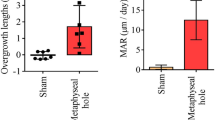Summary
The distal growth plate of the radius was exposed in young rats and the perichondrial ring and fibrous covers were removed at the exposed surface. In addition, a small portion of either the adjacent epiphysis or of the adjacent metaphysis was removed also. In the following days, important alterations in bone structure were observed at the level of the removed perichondrial ring. The most relevant changes were an enlargement of the growth plate at the exposed surface that grew in an abnormal direction, proliferation of bone trabecules at the level of the excised perichondrial ring, and bending of the bone. No regeneration of the perichondrial ring occurred. These changes support both the role of the perichondrial ring in the mechanical constraint of the growth plate, and the induction of bone formation by the hypertrophic cartilage at the level of the absent perichondrial ring.
Similar content being viewed by others
References
Lacroix P (1947) Organizers and the growth of bone. J Bone Jt Surg 29:292–296
Ranvier L (1873) Quelques faites relatifs au développment du tissu osseaux. Comptes Rendues Acad Sci (Paris) 77:1105–1109
Shapiro F, Holtrop ME, Glimcher MJ (1977) Organization and cellular biology of the perichondrial ossification groove of Ranvier. A morphological study in rabbits. J Bone Jt Surg A 59:703–723
Balmain N, Moscofian A, Cuisinier-Gleizes P (1983) The mineralized ring, a single structure peculiar to long bone growth. Calcif Tissue Int 35:232–236
Keith A (1919-1920) Studies on the anatomical changes which accompany certain growth disorders of the human body. J Anat 54:101–115
Rang M (1969) The growth plate and its disorders, The Williams and Wilkins Co, Baltimore
Trueta J, Trias A (1957) La etiología y patogenia del húmero varo. Rev Ortop Traumatol 1:107–116
Santoro G, Cuzzocrea D (1963) Richerche sperimentali sulla soppresione del circolo metafisario della cartilagine di accrescimento. Acta Ortop Ital 9:41–57
Rodríguez JI, Perera A, Regadera J, Collado F, Contreras F (1982) Osteogénesis imperfecta. II Estudio anatomopatológico (óptico y ultraestructural) de 8 casos autopsiados. An esp Pediatr 17:18–33
Rigal WM (1961) Proceedings and reports of universities. J Bone Jt Surg B 43:180–195
Author information
Authors and Affiliations
Rights and permissions
About this article
Cite this article
Rodríguez, J.I., Delgado, E. & Paniagua, R. Changes in young rat radius following excision of the perichondrial ring. Calcif Tissue Int 37, 677–683 (1985). https://doi.org/10.1007/BF02554930
Issue Date:
DOI: https://doi.org/10.1007/BF02554930




